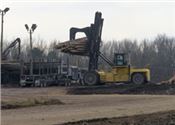|
Forestry Gains Lost Ground While Holding No. 2 Ag Spot

Freshly cut timber is unloaded at Southeast Timber Products in Ackerman, Mississippi, on Dec. 6, 2018. Early
indications are that the state’s timber industry should match its 2017 $1 billion value.
Photo by MSU Extension Service/Kevin Hudson
STARKVILLE, MISS.
Forestry has been a billion-dollar heavyweight in the state’s economy for the last six years, and the 2018 estimated value of $1.25 billion came despite a sluggish market.
John Auel, a Mississippi State University Extension Service assistant professor of forestry, said final figures will not be available until January, but indications are that the industry is on par with its 2017 value to the state. Forestry remains the state’s No. 2 agricultural commodity, just behind poultry.
“We base our estimates of the value of forestry on severance tax collections, and as of the end of November, we are actually ahead by about $200,000 in collections,” Auel said. “That means we seem to be on track or higher than the previous year.”
Mississippi’s timber industry has been making a slow recovery since the 2007–2009 recession. Forestry’s value to the state is up more than 40 percent from the recent low in 2009.
Auel said housing starts have stagnated in recent years, and sawtimber prices closely reflect the rate of new home building. Pine sawtimber typically contributes 60 percent to the overall forestry value.
“A good housing starts rate is 1.5 million a year, but several factors have left the U.S. stuck at about 1.2 million units for the last few years,” he said. “Housing starts should get back to this level by 2022, but it’s going to take an extended time rather than a rapid increase like we expected.”
Because of recent slower demand, Mississippi landowners have a lot of sawtimber still growing that is ready for harvest.
“In some areas, we’ve got 10 to 20 years of sawtimber standing on the ground, and if many more years pass, that timber is going to get too big for the mills to process,” Auel said. “This excess supply has a downward effect on price.”
Pine sawtimber prices averaged $22 a ton in Mississippi in 2018. Pine pulpwood is a much lower-value timber product; this year, it had an average price of $5 per ton.
“Mississippi pulpwood markets are more limited north of Interstate 20 than they are in the southern part of the state,” Auel said. “Demand is low right now.”
Previously, two large pulpwood mills drew from the north Mississippi market, but the one in Alabama closed. The closure decreased demand in this timber-rich area, and now there is excess supply.
However, the long-term outlook for forestry is positive. Lara Bowman, economic development director with the Enterprise of Mississippi, represents interests in Choctaw and Webster counties.
“The east-central area of the state is called the wood basket of Mississippi. We have more available timber to harvest than anywhere else in the state,” Bowman said. “Two existing lumber mills within 90 miles of this area are both planning significant expansions. This will modernize equipment and expand the mills’ operation and production capacity, in addition to hiring more employees.”
These expansions will take time but will increase demand for timber in the northern part of the state.
“This won’t be an immediate answer to the timber woes, but the outlook is better in our area as far as demand,” she said. ∆
|
|